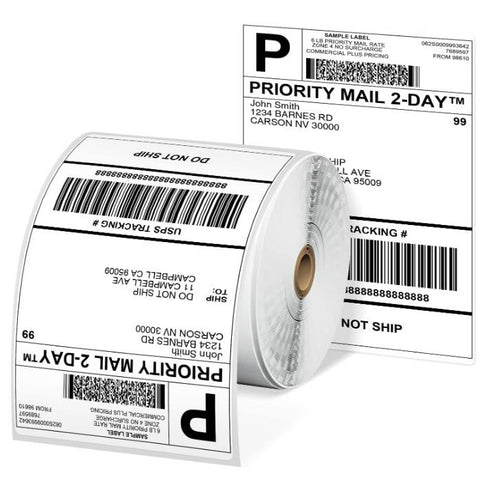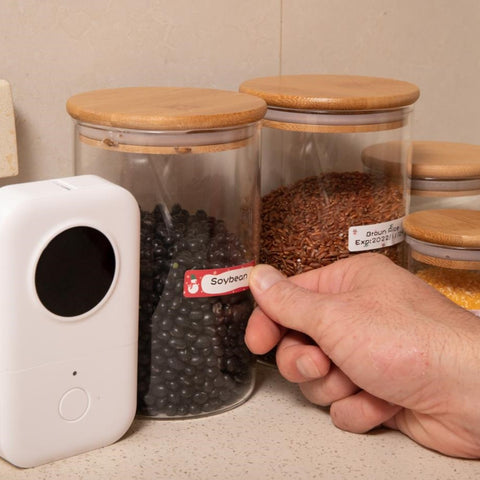Anyone thinking about buying a label printer for the first time is often confronted with two different types of product: direct thermal printers (often simply referred to as "thermal printers") and thermal transfer printers. Both direct thermal and thermal transfer printers are used for printing high-quality labels and various printed media. To choose the right label printer, read this article to become familiar with these two printing technologies.
How direct thermal printers and transfer thermal printers work?
Both direct thermal printing and thermal transfer printing use a heated print head to transfer images onto labels.
The main difference is that thermal transfer printing uses a heated ribbon to transfer the ink to the labels, while direct thermal printing uses a special paper coated with chemicals that darken when heated. Neither ribbon nor ink is required for this printing process.

What are the advantages and limitations of direct thermal printing and thermal transfer printing?
Direct thermal and thermal transfer - these two technologies serve similar purposes for different applications. Both technologies have their own additional advantages and disadvantages.
Advantages of direct thermal printing:
- Cost-effectiveness: direct thermal printing is generally more cost-effective as no ink, toner or ribbons are required.
- No ink, toner, ribbons: without ink, toner or ribbons, direct thermal printing simplifies the printing process and reduces maintenance.
- Easy to use:direct thermal printers are also accessible to non-technical users. They are generally easy to set up and have simple interfaces.
- Quick and efficient printing: direct thermal printers can print large quantities in a short time.

Advantages of thermal transfer printing:
- Color printing:a major advantage of thermal transfer printing is the ability to use ribbons to produce colorful labels, making it suitable for applications that require an eye-catching appearance.
- Extremely scratch resistant :thermal Transfer labels are extremely durable and scratch resistant, ensuring that printed information remains legible even in demanding environments.
- High-durability:thermal transfer labels are designed to withstand sunlight, extreme temperatures and harsh environmental conditions, making them suitable for indoor and outdoor use.
- Not fades easily: thermal transfer printing produces durable, fade-resistant prints that ensure labels and tags maintain their clarity and legibility over time.

Limitations of direct thermal printing:
- No color printing:direct thermal printing is limited to monochrome or black-and-white options.
- Lack durability:direct thermal printing can fade over time and has a shorter lifespan compared to thermal transfer printing.
- Limited applications: direct thermal labels are sensitive when exposed to heat, sunlight or other harsh conditions.
Limitations of thermal transfer printing:
- Ribbons are necessary: thermal transfer printing requires ribbons, which increases the overall cost.
- Ribbon replacement: setting up and changing the ribbon requires additional time.
- Print speed: thermal transfer printing tends to be slower compared to direct thermal printing, which affects overall efficiency.
Which kind of thermal printer should I choose?
For short-term applications, direct thermal printers are an ideal choice. These printers do not require ink or ribbons, which are not only easy to use but also offer a wide range of customized patterns. Direct thermal labels are widely used in areas such as:
- Shipping labels: efficient tracking and identification of parcels in shipping and logistics processes.
- Labels for temporary products: such as food labels, providing temporary labeling solutions for fast-moving products.
- Price labels: facilitates fast and accurate price labeling of goods.
- Name tags: create personalized name badges for events, conferences or workplaces to improve identification and organization.
- Other applications: barcode labels, tickets, receipts and much more.

For long-term applications, thermal transfer printer is a good choice. Thermal transfer labels can withstand harsh conditions such as chemicals, heat, oil or water. Here are some of the most common uses of thermal transfer labels:
- Wire and cables: thermal transfer labels are ideal for the clear and permanent marking of cables and wires, even in harsh environments.
- Asset tracking: thermal transfer labels offer a long shelf life and allow assets to be accurately tracked throughout their lifecycle.
- Laboratory: thermal transfer labels can withstand chemicals, solvents and extreme temperatures.
- Outdoor usage: labels are exposed to sunlight, moisture and harsh weather conditions. Thermal transfer labels are preferred because they maintain their legibility and durability over time.
- Other applications: thermal transfer labels are also used in various other areas such as manufacturing, logistics, healthcare and retail where durable labeling is essential for inventory management, product identification and regulatory compliance.

Need more?
After reading this article, if you're not sure which specific product from Phomemo is right for you, just leave a comment below. We will recommend the best product for your needs. Phomemo is always here and ready to assist you!

 Phomemo PM241-BT Bluetooth Shipping Label Printer
Phomemo PM241-BT Bluetooth Shipping Label Printer
 Phomemo Thermal Portable Printer M832 Upgrade
Phomemo Thermal Portable Printer M832 Upgrade
 Phomemo M02 PRO Bluetooth Mini Printer
Phomemo M02 PRO Bluetooth Mini Printer
 Phomemo M08F Wireless Tattoo Stencil Printer
Phomemo M08F Wireless Tattoo Stencil Printer
 Phomemo M220 Bluetooth Portable Thermal Business Label Maker
Phomemo M220 Bluetooth Portable Thermal Business Label Maker
 Phomemo Instant Camera K22 Dual-Lens Camera for Kids
Phomemo Instant Camera K22 Dual-Lens Camera for Kids
 Phomemo Thermal Transparent Sticker Paper | 50mm For T02/M02X | Rose/Blue/Green 3 Rolls
Phomemo Thermal Transparent Sticker Paper | 50mm For T02/M02X | Rose/Blue/Green 3 Rolls
 Phomemo Fake Skin Tattoo Inspires Creative Tattoo Ideas
Phomemo Fake Skin Tattoo Inspires Creative Tattoo Ideas
 For P02
For P02
 Phomemo Instant Camera P02 Kids Camera Bluetooth Instant Print
Phomemo Instant Camera P02 Kids Camera Bluetooth Instant Print
 Phomemo M02 Mini Printer Gift Set
Phomemo M02 Mini Printer Gift Set
 Phomemo M02S Mini Printer Gift Set
Phomemo M02S Mini Printer Gift Set
 Phomemo M110 Bluetooth Label Maker Gift Set
Phomemo M110 Bluetooth Label Maker Gift Set
 Phomemo M02 PRO Mini Printer Gift Set
Phomemo M02 PRO Mini Printer Gift Set
 Phomemo D30 Bluetooth Home Label Maker & 3 Rolls of Labels Gift Set
Phomemo D30 Bluetooth Home Label Maker & 3 Rolls of Labels Gift Set
 Accessories
Accessories
 Storage Bags
Storage Bags
 Storage Boxes
Storage Boxes
 Phomemo T02 Inkless Mini Printer
Phomemo T02 Inkless Mini Printer
 Phomemo M02 Inkless Mini Printer
Phomemo M02 Inkless Mini Printer
 Phomemo M02S Bluetooth Mini Printer
Phomemo M02S Bluetooth Mini Printer
 Phomemo M04S Mini Thermal Printer
Phomemo M04S Mini Thermal Printer
 Phomemo D30 Portable Bluetooth Home Label Maker
Phomemo D30 Portable Bluetooth Home Label Maker
 Phomemo A30 Portable Home Label Maker
Phomemo A30 Portable Home Label Maker
 Phomemo P12 Pro Bluetooth Home Label Maker
Phomemo P12 Pro Bluetooth Home Label Maker
 Phomemo P15 Vintage Home Label Maker
Phomemo P15 Vintage Home Label Maker
 Phomemo P12 Portable Bluetooth Home Label Maker
Phomemo P12 Portable Bluetooth Home Label Maker
 Phomemo M110 Bluetooth Portable Thermal Business Label Maker
Phomemo M110 Bluetooth Portable Thermal Business Label Maker
 Phomemo M221 Bluetooth Portable Thermal Business Label Maker
Phomemo M221 Bluetooth Portable Thermal Business Label Maker
 Phomemo M150 Bluetooth Portable Thermal Business Label Maker
Phomemo M150 Bluetooth Portable Thermal Business Label Maker
 Phomemo M250 Bluetooth Portable Thermal Business Label Maker
Phomemo M250 Bluetooth Portable Thermal Business Label Maker
 [WIFI] Phomemo PM344-WF 300DPI Shipping Label Printer
[WIFI] Phomemo PM344-WF 300DPI Shipping Label Printer
 Phomemo PM249-BTZ Bluetooth Direct Connect Shipping Label Printer
Phomemo PM249-BTZ Bluetooth Direct Connect Shipping Label Printer
 Phomemo D520-BT Bluetooth Shipping Label Printer
Phomemo D520-BT Bluetooth Shipping Label Printer
 Phomemo PM-246S High-Speed USB Direct Thermal Shipping Label Printer
Phomemo PM-246S High-Speed USB Direct Thermal Shipping Label Printer
 Phomemo M08F Letter & A4 Portable Printer
Phomemo M08F Letter & A4 Portable Printer
 Phomemo P831 Bluetooth Portable Thermal Transfer Printer
Phomemo P831 Bluetooth Portable Thermal Transfer Printer
 【Ultra-light】Phomemo Q302 Wireless Portable Thermal Printer
【Ultra-light】Phomemo Q302 Wireless Portable Thermal Printer
 Phomemo Thermal Portable Printer M834 Bluetooth
Phomemo Thermal Portable Printer M834 Bluetooth
 Phomemo TP31 Bluetooth Tattoo Stencil Mini Printer
Phomemo TP31 Bluetooth Tattoo Stencil Mini Printer
 Phomemo TP81 Wireless Tattoo Template Printer
Phomemo TP81 Wireless Tattoo Template Printer
 Phomemo TP87 Wireless Tattoo Template Printer
Phomemo TP87 Wireless Tattoo Template Printer
 Phomemo TP83 Wireless Tattoo Stencil Printer
Phomemo TP83 Wireless Tattoo Stencil Printer
 For T02/M02X
For T02/M02X
 For M02
For M02
 For M02S
For M02S
 For M02 PRO
For M02 PRO
 For M03
For M03
 For M04S
For M04S
 For M04AS
For M04AS
 For P2S
For P2S
 For D30/D35/Q30/Q30S
For D30/D35/Q30/Q30S
 For P15/A30
For P15/A30
 For P12/P12 PRO
For P12/P12 PRO
 For D50
For D50
 For M960/M950
For M960/M950
 For P3200
For P3200
 For M110/M120/M150
For M110/M120/M150
 For M200/M220/M221/M250
For M200/M220/M221/M250
 For M421
For M421
 Phomemo 4"x6" Fan-Fold Thermal Direct Labels for Shipping Label Printer
Phomemo 4"x6" Fan-Fold Thermal Direct Labels for Shipping Label Printer
 Phomemo 2" Multiple Thermal Round Label for Shipping Label Printer
Phomemo 2" Multiple Thermal Round Label for Shipping Label Printer
 Phomemo 2" Silver Thermal Holographic Sticker for Shipping Label Printer
Phomemo 2" Silver Thermal Holographic Sticker for Shipping Label Printer
 Phomemo 2.25”x1.25” Square Thermal Labels For Shipping Label Printer (Roll of 1000 Labels)
Phomemo 2.25”x1.25” Square Thermal Labels For Shipping Label Printer (Roll of 1000 Labels)
 Phomemo 3"x2" Shipping Label Stickers for Shipping Label Printer
Phomemo 3"x2" Shipping Label Stickers for Shipping Label Printer
 For M08F
For M08F
 For M832
For M832
 For P831
For P831
 For TP81/TP83/M08F Tattoo
For TP81/TP83/M08F Tattoo
 For TP31 Tattoo
For TP31 Tattoo













